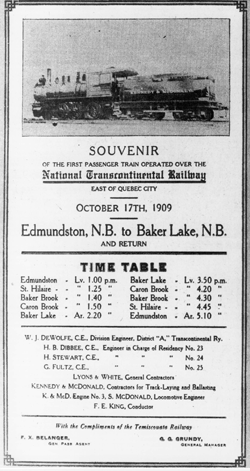National Transcontinental Railway Reporting mark: NTR
The National Transcontinental Railway (NTR) began as a partnership deal between the federal government and the Grand Trunk Railway (GTR).

Université de Moncton
The GTR had wanted to expand into western Canada. Unable to strike a deal with the Canadian Northern Railway (CNoR) they approached the federal government in 1903 looking for assistance and a handout. Eventually the two parties reached an agreement whereby the GTR would build the Grand Trunk Pacific Railway (GTPR), which was to run from Winnipeg to Prince Rupert, B.C. and the government would build the NTR, which would run from Winnipeg east to Moncton. The NTR in turn was to be leased back to the GTR, who would assume full operations. The construction of both railways was almost entirely financed by the government.
The government had reasons of their own for building the NTR. These included a plan to open up northern Ontario and Quebec and drive more rail traffic to Quebec City, and also to provide a connection to the government owned Intercolonial Railway (ICR) in the Maritimes, which they hoped would lead to improved shipping connections.
Construction began in 1905. Tragedy struck in 1907 with the collapse of the bridge in Quebec City. The bridge, which was to span the St. Lawrence River, was to be the largest cantilever bridge in the world. It was close to completion when it collapsed on August 29, killing 75 workers. A second accident during reconstruction of the bridge in 1916 took another 11 lives.

National Archives, MIKAN 3523471. Photo: Dominion Bridge Co. Ltd.
From the outset, the NTR was built to an exceptionally high standard. Virtually all new railways were built economically to a minimum standard with a plan to upgrade as traffic and condition warranted. The government however spared no expense in the construction of the NTR. As a result cost overruns were in excess of 100 per cent over and above the original estimate.
The NTR, apart from the bridge, was completed in 1913 and the GTPR completed in 1914. However the cash strapped GTR reneged on its deal to run the NTR. The NTR was placed under the umbrella of the Canadian Government Railways (CGR), and then folded into the Canadian National Railways, along with the CNoR and later the GTR and GTPR. In 1923 all became part of the Canadian National Railway (CN).
Despite being one of the best constructed railways in the world, the NTR was never a major revenue producer. The section running from Nakina, Ontario to Calstock, Ontario was abandoned in 1986, and the portion from Cochrane, Ontario to La Sarre, Quebec, abandoned in 1997. The section from Calstock to Cochrane was sold to the Ontario Northland Railway in 1993 and remains in use. The section running west from Nakina continues to form part of CN's main line and sees very heavy traffic.
